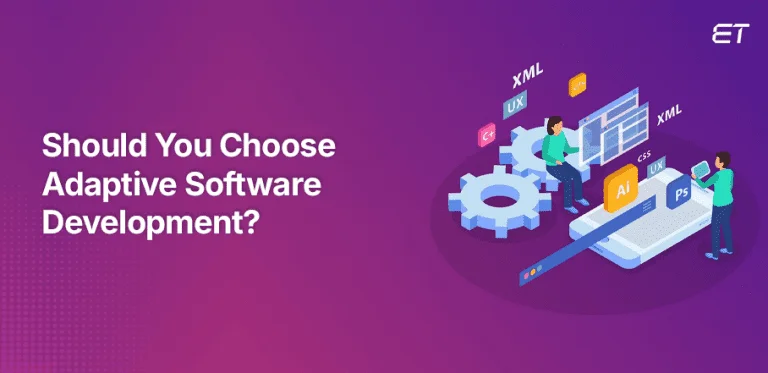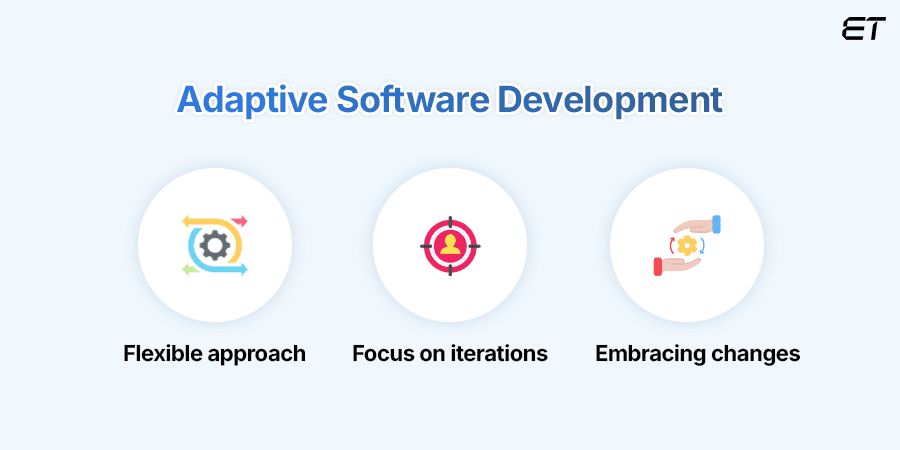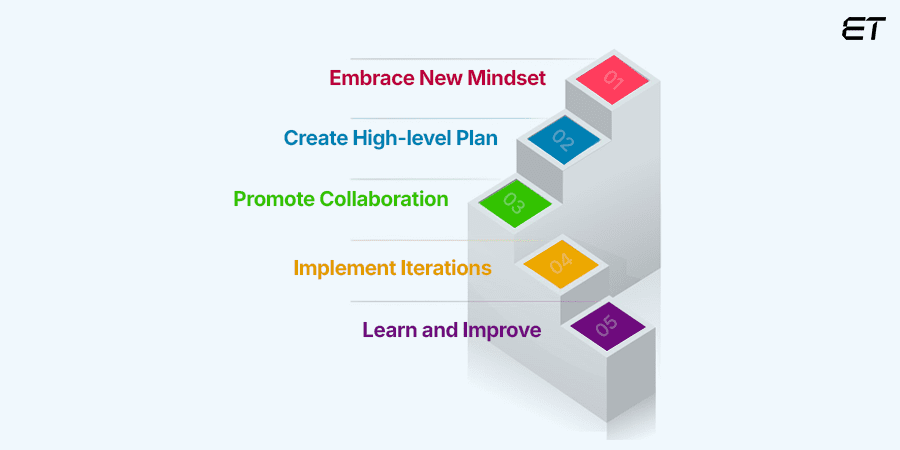
Understanding Adaptive Software Development (ASD) – Detailed Guide
- Adaptive Software Development (ASD) is a flexible and iterative approach that prioritizes continuous improvement and adaptability to changing software requirements
- The key principles of ASD include a focus on people, iterative development, continuous testing, and embracing change
- The ASD lifecycle consists of three phases – Speculate, Collaborate, and Learn
- Benefits of ASD include increased flexibility, faster time-to-market, improved customer satisfaction, enhanced collaboration, and reduced project risk
- The challenges include the need for experienced teams, the potential for scope creep, reliance on customer involvement, and difficulty in estimating project timelines and costs
- ASD is best suited for projects with uncertain or changing requirements, where customer satisfaction is a top priority, and where rapid delivery and frequent updates are needed
‘Adaptability is the simple secret of survival.’ – Jessica Hagedorn.
This quote from one of the most well-known American authors is pertinent to signify the importance of adaptive software development (ASD). As an IT professional, you’re likely familiar with methodologies like Agile, Waterfall, and DevOps. ASD shares similarities with these approaches but places a unique emphasis on continuous improvement and flexibility.
Unlike traditional methods that follow a rigid plan, ASD embraces change and adapts to evolving requirements. This philosophy empowers teams to deliver high-quality software products efficiently, even in dynamic and unpredictable environments.
Implementing adaptive software development can be crucial if you want to survive in today’s competitive space. Scroll ahead to learn the concept in depth and find out how you can include ASD in your workflow.
Looking for skilled developers adept in adaptive software development?
What is Adaptive Software Development (ASD)?

To understand the concept of ASD, you must first know the fundamental meaning of software development.
In simple words, software development is the process in which IT professionals cover various technical aspects to bring your idea into digital reality. In a conventional procedure, these programmers or developers accomplish the following steps:
- Requirement gathering
- Design
- Development
- Testing
- Deployment
- Maintenance
The end product? Software development can lead to the launch of digital applications, smartphone apps, web portals, or enterprise solutions.
Now, the adaptive software development model is a subset of the above process.
In other words, if conventional software development is an ocean, ASD is an island within it. This methodology focuses on flexibility and embraces change. It has the following three characteristics:
- Flexibility
- Iterative nature
- Responsiveness
So, in essence, one can define adaptive software development as a methodology that prioritizes flexibility, continuous improvement, and collaboration to deliver a successful IT project. Consider it to be a specialized approach for rapid application development.
A Brief History of Adaptive Software Development (ASD)
The concept of adapting to change in software development has been around for decades. However, the formalization of Adaptive Software Development (ASD) traces back to the late 1990s.
It emerged as a response to the increasing complexity of software projects and the need for more flexible development methodologies.
The following factors played a major influence on ASD:
- The Agile Manifesto: The Agile Manifesto (published in 2001) emphasized principles such as customer satisfaction, iterative development, and embracing change. These principles aligned with the core beliefs of ASD
- The rise of the Internet: The rapid growth of the Internet and e-commerce in the late early 2000s created a demand for software that could quickly adapt to changing market conditions and user needs
- The limitations of traditional methodologies: Traditional methodologies like Waterfall were too rigid to meet the dynamic nature of software development projects
ASD has evolved over the years, but its core principles remain relevant. It continues to be a valuable tool for teams aspiring to deliver high-quality software products.
Getting Conversant with the Adaptive Software Development Framework

You must be thinking – ‘why should I choose ASD over conventional software development?’
In reality, this thinking can be logical. Why implement something new if tried-and-tested methods produce good results, right?
Well, to get the answer, you need to understand the adaptive software development framework. Here are the key principles of ASD:
- Focus on People: Successful software development depends on effective collaboration among team members
- Iterative Development: You break the project into small, iterative cycles, allowing for continuous improvement
- Continuous Testing: In ASD, you integrate testing throughout the development process to ensure quality
- Embrace Change: ASD acknowledges that change is inevitable and encourages teams to adapt to evolving requirements and leverage the agile framework
This unique approach to developing software helps overcome the common challenges in the conventional methodology.
An agile team can implement ASD profoundly. Partner with us to get dedicated assistance from our agile experts.
Adaptive Software Development Lifecycle

Three core phases define ASD’s offbeat lifecycle. You can abbreviate them as ‘SCL.’
- Speculate
- Collaborate
- Learn
In the first phase, you must shift your focus to creating a top-tier vision for the project. Plan and set goals for necessary iterations and identify potential challenges.
The next adaptive software development phase emphasizes team members’ collaborative work. You should cultivate a culture of open communication, continuous learning, and reiterate the importance of continuous integration and testing. Finally, it is time to evaluate the results of iterations.
Gather feedback from stakeholders and adjust your plans accordingly. This phase completes the flexible approach to ASD and also covers the process of managing complex systems.
Benefits of Adaptive Software Development Model
Once you implement the three phases systematically, your team can notice specific positives. The following table contains a quick look at the main advantages.
| Increased adaptability | Faster time-to-market |
| Enhanced collaboration | Improved product quality |
| Boost in customer satisfaction | |
Overall, adaptive software development can help create a work culture that improves revenue, augments teamwork, and retains customers in the long run.
How to Implement Adaptive Software Development?

If ASD interests you, it is equally important to understand the steps you can take to ensure its seamless implementation. Notably, you do not need to read an adaptive software development book to perform these steps. Scroll ahead and follow a practical approach.
Step 1: Adopt the ASD Mindset
Since adaptive software development is offbeat, you need to discuss it with your team members.
To embrace the ASD mindset, it is crucial to understand the following points:
- Invest in building strong teams with open communication and collaboration
- Accept that requirements will change, and the product will evolve over time
- Cultivate a culture that welcomes change as an opportunity for improvement
Basically, the successful implementation of adaptive software development depends on the curiosity and open-minded nature of your team. You can perform the following actions for building a group that can apply this methodology to any software project:
- Provide training to employees on ASD principles and methodologies
- Implement change management strategies to facilitate the transition
- Ensure that leadership supports the ASD approach and encourages the desired behavior
All in all, shift your focus from the traditional approach and welcome a new methodology positively.
Have a fixed-cost project but want to implement sound agile strategies to boost your output? Get to know all the vital details.
Step 2: Formulate the ASD Plan
For successful implementation of adaptive software development, you need a well-defined roadmap. In the beginning, you can explore real-world examples to understand the methodology.
This study can help establish a plan that works wonders.
You can divide the ASD plan into three segments:
- Project Vision Definition
- Stakeholder Identification
- Formulation of the Roadmap
The following table briefly explains each segment.
| Section | Explanation |
| Project Vision | Communicate the overall goals and objectives of the project. Focus on developing a concise and inspiring mission statement |
| Stakeholders | Identify all individuals or groups who have an interest in the project. Define the roles and responsibilities of each stakeholder for heightened clarity |
| Roadmap | Outline the project’s overall direction and major milestones. You can use diagrams or charts to visualize the roadmap for better understanding |
Remember, the trick in ASD is to avoid excessive details. The best adaptive software development examples are the ones that undergo continuous refinement.
Step 3: Promote the Collaborative Spirit
Once you have a clear set of objectives, building a web development team that delivers excellent results is vital. For this purpose, focus on cross-functionality.
Assemble teams with a blend of skills, including project managers, developers, designers, testers, content writers, SEO specialists, and subject matter experts. Also, you should ensure that your team members have a common understanding of the project’s objectives.
At the same time, you should choose software development collaboration tools that simplify project management. Here are some well-known names:
While choosing tools, focus on ergonomics, scalability, and integration capabilities. Above all, ensure you promote open communication to boost a collaborative project management approach. For instance, relevant information should be freely available to all team members. In addition, you should encourage active listening to ensure that everyone’s perspective finds the right platform and consideration.
Want to know proven tactics to boost team collaboration? This blog that can help enhance your augmented team.
Step 4: Implement Iterative ASD
This stage is the most vital step in adaptive software development. Consider it the ‘coding’ of the entire process. To find success through this methodology, you can perform the following actions:
- Break down your project into smaller iterations
-> Determine the optimal length of each iteration based on project complexity and team dynamics
-> Divide the project into manageable features or user stories
-> Rank features based on business value and customer needs - Set clear objectives for each iteration
->Formulate SMART (Specific, measurable, achievable, relevant, and time-bound) goals
-> Focus on delivering tangible results rather than completing tasks in a hurry
-> Ensure that each iteration contributes to the project’s core objectives - Assess and adjust for optimum impact
-> Conduct regular reviews to assess progress and identify areas for improvement
-> Incorporate feedback from customers, stakeholders, and team members
-> Adjust plans based on new information or changing conditions
Your main intention should be to deliver working software at the end of every iteration. For the best results, you can involve the target user in your adaptive software development process and benefit from this new project management approach.
Step 5: Prioritize Continuous Improvement
This final step is similar to the quality assurance stage in software development. It comes at the end but is crucial for long-term success.
To establish a culture of continuous improvement and learning, you can follow the ‘ERS’ model:
- E: Experiment
- R: Retrospect
- S: Share
The work culture should encourage experimentation and promote vigor in trying new strategies to develop complex software systems. By creating a safe environment for teams to experiment without fear of failure, you can help them succeed.
For retrospection, you can dedicate time for software development teams teams to reflect on each iteration and identify the critical lessons. Use retrospectives to identify areas for improvement in the adaptive software development process.
Finally, the ‘share’ aspect involves sharing knowledge and best practices. For this purpose, you can provide opportunities for mentoring and coaching to develop the workgroup.
With 22+ years of experience, our team possess veteran experts who can assist you for continuous IT improvement.
Strengths and Weaknesses of Adaptive Software Development
Any software development methodology has its own strengths and challenges, and adaptive software development is no different.
Before choosing this approach, you should analyze the table below. It will facilitate proper decision-making since it covers all vital aspects of software development.
| Strengths | Weaknesses |
| Flexibility and adaptability | Lack of upfront planning |
| Customer satisfaction | Potential for scope creep |
| Faster time-to-market | Dependency on customer involvement |
| Enhanced collaboration | Difficulty in estimating project timelines |
| Reduced risk | Requires skilled and experienced teams |
So, is adaptive software development the right methodology for you? The answer lies in the honest analysis of the above strengths and weaknesses. Still, to help you make the best decision, refer to the next section.
Is Adaptive Software Development Suitable For Me?

To choose or not to choose is the main dilemma, right?
Well, the choice of implementing ASD depends on the following factors:
- Project
- Team
- Miscellaneous
In simple words, you can choose adaptive software development if:
- Your project has rapidly changing requirements
- You value flexibility in your development process
- Customer satisfaction is a top priority
- You have a collaborative team that thrives on change
On the other hand, ASD can be an unwise choice if:
- Your project has well-defined and stable requirements
- You need strict adherence to timelines and budgets
- Your team is inexperienced with agile methodologies
- You have limited customer involvement or feedback
So, continually assess your business and project requirements before taking the final call. Remember, you can always team up with experienced staff augmentation experts to implement ASD proficiently.
Need to get on a call to discuss your project suitability for ASD?
Bonus: Adaptive Software Development Example (Hypothetical)

Consider a scenario in which a startup wants to develop a food-ordering app for smartphones. The startup team is unsure of the exact features that will resonate with customers, but it wants to enter the market quickly.
In this case, they can follow the adaptive software development approach. How?
You remember the lifecycle phases, right? Speculate, Collaborate, and Learn. The same phases are applicable to all projects. For this example, consider the following points.
| Phase | Activities |
| Speculate | Identify core functionalities like user registration, menu display, order placement, payment integration. Next, form a cross-functional team and create a high-level roadmap with potential features like a loyalty program, delivery options, and more |
| Collaborate | Develop a minimum viable product (MVP) with core functionalities. Conduct usability testing with a small group of users and gather feedback into the next iteration |
| Learn | Analyze user data and feedback. Identify top-performing features and areas for improvement. Notably, prioritize features for the next iteration based on user feedback and business goals |
Now, the startup can proceed to the iteration phase. In iteration one, the team implements the most popular features from user feedback. Next, it conducts A/B testing on different UI designs.
Based on the data, it expands the app to include more restaurants and cuisines.
The final iteration introduces delivery options based on user demand. The start-up team implements push notifications for order updates and promotions. What’s next?
They monitor user behavior, app store reviews, and market trends. These data-driven insights help develop relevant features and meet customer demand.
Wrapping Up
Adaptive software development (ASD) is a subset of the conventional digital app-building process. This methodology focuses on flexibility and continuous improvement.
If you adopt this tactic, you may notice several benefits, such as increased customer satisfaction, faster time to market, enhanced collaboration, and improved product quality. However, you need to perform specific steps to increase the chance of success through this development approach.
Adopting the right mindset, formulating a high-level plan, and establishing a collaborative culture are the foundational steps of ASD. Next, you should perform qualitative iterations to leverage the data-driven insights. Finally, a complete adaptive software development cycle should include steps for continuous improvement.
Even though ASD has several key benefits, it is unsuitable in specific scenarios. If you lack experience in agile methodologies and strictly adhere to timelines and budgets, refrain from choosing this approach. However, if you still want to notice the advantages, partner with an adaptive software development company and explore this methodology to get the best results.
Want to plan your adaptive software project today?
Frequently Asked Questions
1. What are adaptive software development advantages and disadvantages?
ASD’s most significant advantage is its flexibility. It allows teams to quickly adapt to changing requirements and ensures that the final product aligns closely with customer needs and market trends. On the other hand, it is less structured and more complex to manage than other conventional rigid approaches.
2. How does ASD differ from traditional waterfall development?
Unlike waterfall, ASD is iterative and incremental. It focuses on collaboration, continuous feedback, and adaptability. In contrast, the waterfall methodology follows a rigid, sequential process with less room for change.
3. Is ASD suitable for all types of software projects?
Adaptive software development is versatile. However, it is most suitable for projects with uncertain requirements. A more traditional approach might be helpful if you have an IT project with highly stable requirements.
4. What role does testing play in adaptive software development?
Testing is integral to ASD. QA engineers conduct tests continuously throughout the development process to ensure quality and identify issues at an early stage.
5. What is adaptive software used for?
Adaptive software is used to create applications that can change and adapt to new situations or user needs. Developers use algorithms that can learn from data and make decisions based on what they have learned. Adaptive software is applicable in areas where it is difficult to predict all possible scenarios in advance, such as in artificial intelligence and machine learning.
6. What are the characteristics of adaptive software development?
Flexibility, adaptability, and continuous improvement are the main characteristics of ASD. This approach emphasizes iterative development cycles, rapid prototyping, and the ability to respond to changes in requirements or the environment.
7. How does ASD compare to other popular agile software development frameworks?
Adaptive software development differs from other agile frameworks like Scrum and Kanban in its focus on adaptability and continuous improvement. It emphasizes flexibility and the ability to respond to changes throughout the development process. Scrum, on the other hand, is more structured with fixed iterations (sprints) and defined roles. Kanban focuses on visualizing work and limiting work in progress.
8. What is adaptation in software development?
Adaptation is the process of modifying or adjusting software to meet changing requirements. It involves making alterations to the software’s functionality, design, or architecture in response to factors like evolving user needs, technological advancements, or shifting market conditions.
9. What are the essential traits of a good adaptive software development company?
A good adaptive software development company has flexibility and responsiveness to change at the forefront. Such a firm has developers with strong communication skills to collaborate closely with clients. They also promote a culture of continuous learning and improvement to adapt to new technologies and methodologies.





